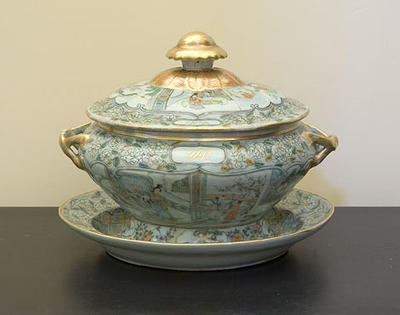Tureen
Maker & role
Unknown
Production date
circa 1850
See full details
Object detail
Production place
Collection
Measurements
1 - Tureen, H: 17 x W: 24 x L: 35.5cm (H: 170 x W: 240 x L: 355mm); 2 - Lid, H: 7 x W: 22 x L: 27.3cm (H: 70 x W: 220 x L: 273mm); 3 - Stand, H: 5.2 x W: 29 x L: 35cm (H: 52 x W: 290 x L: 350mm)
Production notes
Jingdezhen, Jiangxi province, China; sold via Guangzhou (formerly Canton), Guangdong province, China.
The monogram / initials ‘UP’ may identify the individual or family for whom the service was commissioned.
The monogram / initials ‘UP’ may identify the individual or family for whom the service was commissioned.
Signature & marks
Cartouches enclosing the monogram / initials ‘UP’
Credit line
Gift, through the Australian Government’s Cultural Gifts Program, 2006
Elizabeth Bay House Collection, Museums of History New South Wales
Elizabeth Bay House Collection, Museums of History New South Wales
Caption
Tureen, c1830
Description
Oval soup tureen, cover and stand in Canton overglaze enamel decoration (famille verte palette), the three pieces monogrammed ‘UP’ within oval cartouches. The pieces have gilt edges (with additional bands to the tureen) and borders of scrolling peony on a seeded ground and finely painted domestic scenes of figures at leisure on terraces and in interiors. The tureen lid has an iron-red flower-head finial and gilt entwined strap handles.
Chinese export porcelain (or ‘Chinese export ware’) is a term used to describe porcelain made in Jingdezhen, Jiangxi province, China and sold via Guangzhou (formerly Canton), specificallly for the European market, often to order with specific patterns, crests and monograms as in this example. This trade began in the 16th century, but peaked in the 18th and early 19th century, at which time there was a small but historically significant trade with the colony of New South Wales. Both underglaze ‘blue and white’ porcelain and brightly coloured enamelled porcelain were sold through Canton, with the latter appealing to European tastes of the 1830s – 1900s period (partly owing to the abundance of English blue and white transfer-printed ceramics). ‘Famille vert’ is a form of Chinese porcelain characterised by a brilliant green enamel, often with iron-red, blue, yellow and purple.
This Chinese export monogrammed tureen and stand (originally part of a dinner service) was acquired in the broader context of the Caroline Simpson collection and strengthens Elizabeth Bay House’s important holdings of provenanced decorative arts, without direct reference to the Macleay family. It reflects European trade with China through centres such as Canton in the early-mid 19th century.
Chinese export porcelain (or ‘Chinese export ware’) is a term used to describe porcelain made in Jingdezhen, Jiangxi province, China and sold via Guangzhou (formerly Canton), specificallly for the European market, often to order with specific patterns, crests and monograms as in this example. This trade began in the 16th century, but peaked in the 18th and early 19th century, at which time there was a small but historically significant trade with the colony of New South Wales. Both underglaze ‘blue and white’ porcelain and brightly coloured enamelled porcelain were sold through Canton, with the latter appealing to European tastes of the 1830s – 1900s period (partly owing to the abundance of English blue and white transfer-printed ceramics). ‘Famille vert’ is a form of Chinese porcelain characterised by a brilliant green enamel, often with iron-red, blue, yellow and purple.
This Chinese export monogrammed tureen and stand (originally part of a dinner service) was acquired in the broader context of the Caroline Simpson collection and strengthens Elizabeth Bay House’s important holdings of provenanced decorative arts, without direct reference to the Macleay family. It reflects European trade with China through centres such as Canton in the early-mid 19th century.
Accession number
EB2007/13-1:3



Public comments
Be the first to comment on this object record.